CISCO do it yourself, or an overview of the Lanner FW-7540 network platform
Yes, yes, you can do your own CISCO / Juniper router.
In my posts I will talk about such interesting things as network platforms.

So, for a start, a small definition of this term:
Unified Network Platform (from the Unified Network Platform or UNP) is an open architecture platform that provides convergence of network services, such as:
UNP provides a set of backbone network functions through a combination of open-source operating systems (pfSense, Zentyal, ClearOS, Vyatta, Zeroshell, and many others) with Intel / AMD hardware (VIA, MIPS, etc.) for general purposes. In this bundle, UNP offers the best of its kind flexibility, transparency, scalability, and extensibility.
Simply put, a network platform is hardware designed to work in telecommunication networks, with software installed, tailored for various network tasks (routing, NAT, VPN, proxy, firewall, etc.).
')
What does this mean for system administrators / information security specialists of the company? It's very simple: now, if there is a need to build a powerful router for organizing a corporate VPN gateway, or to get CISCO / Juniper functionality, only for sane money, this is not realizable with something like:
(photo from my-cool-projects.blogspot.ru/2013/03/replacing-my-ancient-linux-router-with.html )
and with the help of quite compact and productive (and sometimes even with passive cooling) iron.
Today I will talk about the Lanner Inc middle-class networking platform FW-7540 :
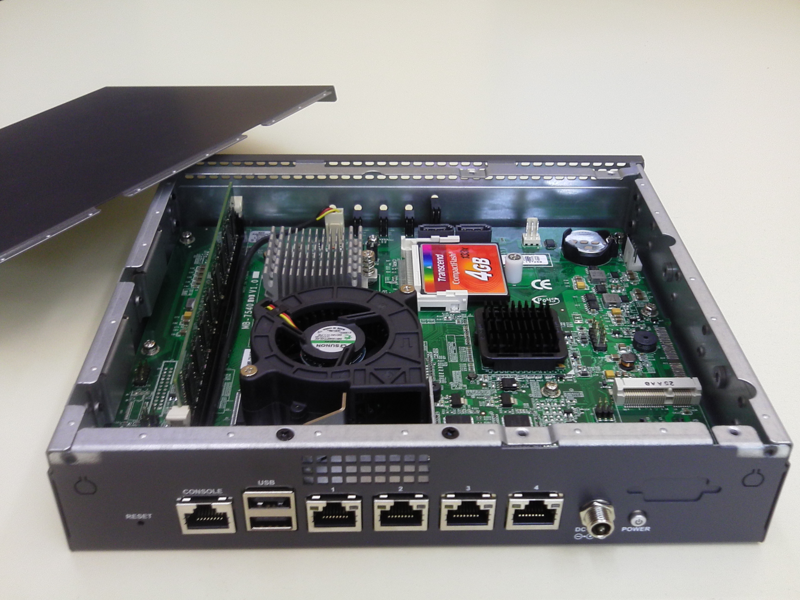
The platform has a soldered dual-core Intel Atom D525 Pineview 45nm CPU with support for up to 4GB DDR3 RAM. To control the device, you can use any x86-compatible operating system (Linux, Windows, pfSense, and many others).
Also, despite the low cost of the device, it has four full-fledged GbE-interfaces, running the controllers Intel 82583V or Intel 82574L:
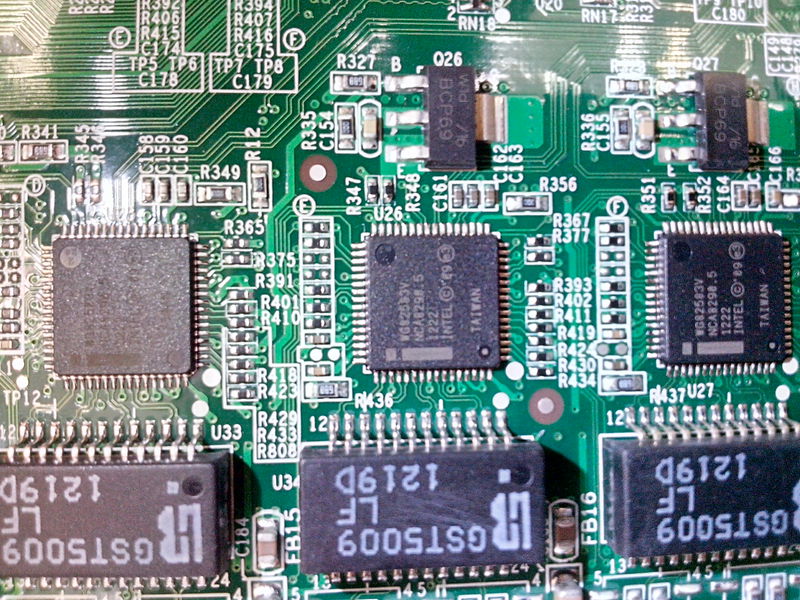
Let us turn to a more detailed overview of the platform.
Specifications:
* Bypass - a function that allows switching the input signal directly to the output, bypassing all the functional blocks. (If the device is “stuck”, traffic switching on these interfaces will continue without interruption in operation).
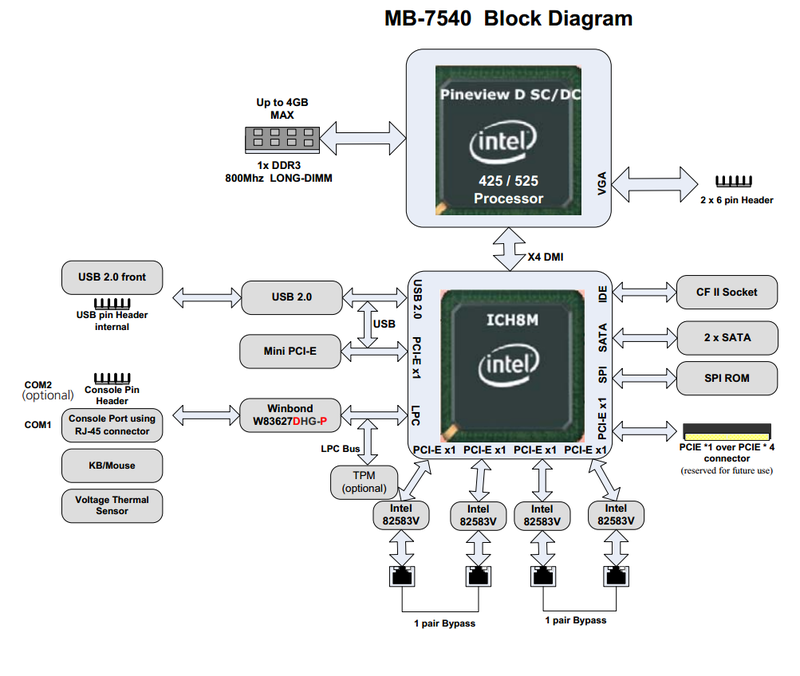
The case of the device is made with high quality, rather thick walls and edges do not cut fingers. On the sides of the case there are holes for fasteners in a 19 ”rack.
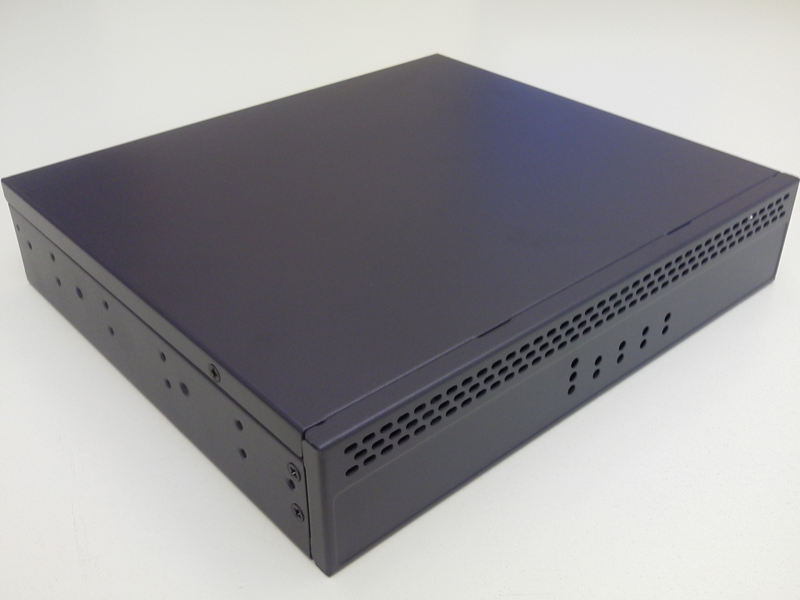
The standard package includes:
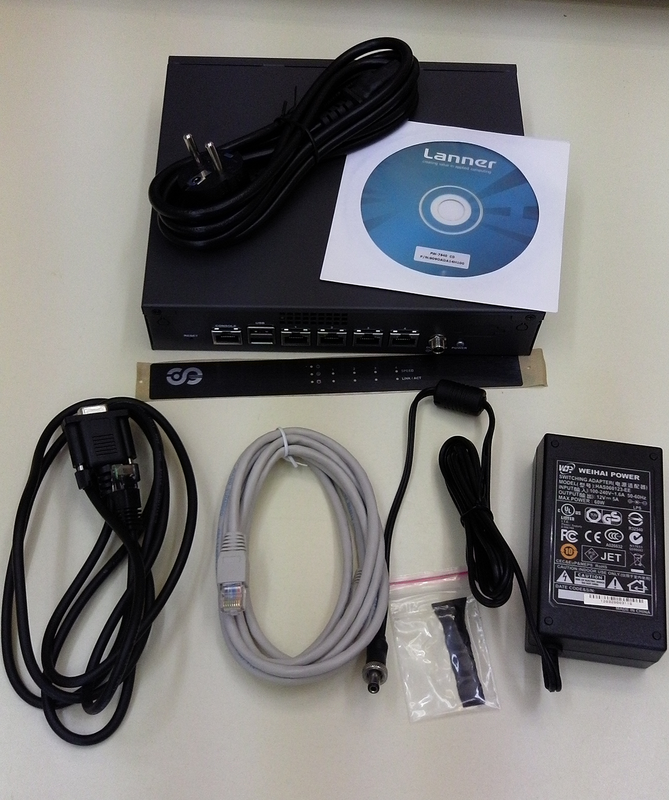
Of the expansion interfaces on the board, there is a Mini-PCIe with a SIM reader for connecting embedded 3G modems. To control the device, the RJ45-console port is used, but the board also has pins for connecting a cable with a VGA connector (DB15), which can be installed in place of the cap on the device wall.
To cool the CPU, a radiator is used, which is quite enough for a “kid” with a TDP 13W. And the only cooler cools the system, expelling heated air.
To manage network platforms, they usually use free open-source software (which is often configured not only from the console, but also via the web interface):
pfSense is a powerful multifunction router on the FreeBSD core,
Vyatta is a JunOS router, on the Debian kernel,
Asterisk - allows you to make a full IP - PBX, can be part of pfSense,
ClearOS , FreeNAS , Zeroshell , etc.
This device is ideal for small and medium businesses. With it, you can build a high-performance distribution node of the corporate network. For example, when installing on a Vyatta OS, you get CISCO / Juniper class equipment at times cheaper.
In the future, I will talk about other models of network platforms (for example, the Swiss company PC Engines), and also describe an interesting experience of their use, configuration, problem solving and, of course, performance testing in comparison with the aforementioned giants (CISCO / Juniper).
Ps. Thank you for your attention, I will be glad to wishes on the topic of the next article.
In my posts I will talk about such interesting things as network platforms.

So, for a start, a small definition of this term:
Unified Network Platform (from the Unified Network Platform or UNP) is an open architecture platform that provides convergence of network services, such as:
- Data Network Management
- Network security
- Network infrastructure
- Network applications
UNP provides a set of backbone network functions through a combination of open-source operating systems (pfSense, Zentyal, ClearOS, Vyatta, Zeroshell, and many others) with Intel / AMD hardware (VIA, MIPS, etc.) for general purposes. In this bundle, UNP offers the best of its kind flexibility, transparency, scalability, and extensibility.
Simply put, a network platform is hardware designed to work in telecommunication networks, with software installed, tailored for various network tasks (routing, NAT, VPN, proxy, firewall, etc.).
')
What does this mean for system administrators / information security specialists of the company? It's very simple: now, if there is a need to build a powerful router for organizing a corporate VPN gateway, or to get CISCO / Juniper functionality, only for sane money, this is not realizable with something like:

(photo from my-cool-projects.blogspot.ru/2013/03/replacing-my-ancient-linux-router-with.html )
and with the help of quite compact and productive (and sometimes even with passive cooling) iron.
Today I will talk about the Lanner Inc middle-class networking platform FW-7540 :

The platform has a soldered dual-core Intel Atom D525 Pineview 45nm CPU with support for up to 4GB DDR3 RAM. To control the device, you can use any x86-compatible operating system (Linux, Windows, pfSense, and many others).
Also, despite the low cost of the device, it has four full-fledged GbE-interfaces, running the controllers Intel 82583V or Intel 82574L:

Let us turn to a more detailed overview of the platform.
Specifications:
- Half-rack device form factor, dimensions 215.5 x 44 x 190mm.
- Intel ICH8M chipset, support up to 4GB DDR3 800Mhz RAM
- 1x CompactFlash Type II socket; 2x SATA2
- Passive cooling of the CPU (radiator), 1x cooler for cooling the system.
- 1x Mini-PCIe + SIM reader.
- 2x USB 2.0
- 60W Power Adapter.
- 4x GbE interface. 4x Intel 82583V / 82574L Controllers.
- 2 pairs of ports with G2 Bypass *
- 1x Console RJ45 port.
- Weight: 1.2 kg.
- BIOS: AMI BIOS, 16Mbit SPI Flash ROM
* Bypass - a function that allows switching the input signal directly to the output, bypassing all the functional blocks. (If the device is “stuck”, traffic switching on these interfaces will continue without interruption in operation).

The case of the device is made with high quality, rather thick walls and edges do not cut fingers. On the sides of the case there are holes for fasteners in a 19 ”rack.

The standard package includes:
- Platform FW-7540B (Modification B indicates the presence of the function Bypass *)
- 60W power adapter, power cable.
- Factory patch cord 2m.
- Console wire DB9-RJ45.
- Sticker on the front side.
- Disk with drivers.
- Rubber feet.

Of the expansion interfaces on the board, there is a Mini-PCIe with a SIM reader for connecting embedded 3G modems. To control the device, the RJ45-console port is used, but the board also has pins for connecting a cable with a VGA connector (DB15), which can be installed in place of the cap on the device wall.
To cool the CPU, a radiator is used, which is quite enough for a “kid” with a TDP 13W. And the only cooler cools the system, expelling heated air.
To manage network platforms, they usually use free open-source software (which is often configured not only from the console, but also via the web interface):
pfSense is a powerful multifunction router on the FreeBSD core,
Vyatta is a JunOS router, on the Debian kernel,
Asterisk - allows you to make a full IP - PBX, can be part of pfSense,
ClearOS , FreeNAS , Zeroshell , etc.
This device is ideal for small and medium businesses. With it, you can build a high-performance distribution node of the corporate network. For example, when installing on a Vyatta OS, you get CISCO / Juniper class equipment at times cheaper.
In the future, I will talk about other models of network platforms (for example, the Swiss company PC Engines), and also describe an interesting experience of their use, configuration, problem solving and, of course, performance testing in comparison with the aforementioned giants (CISCO / Juniper).
Ps. Thank you for your attention, I will be glad to wishes on the topic of the next article.
Source: https://habr.com/ru/post/183582/
All Articles